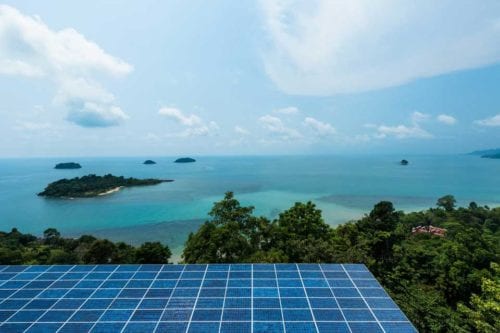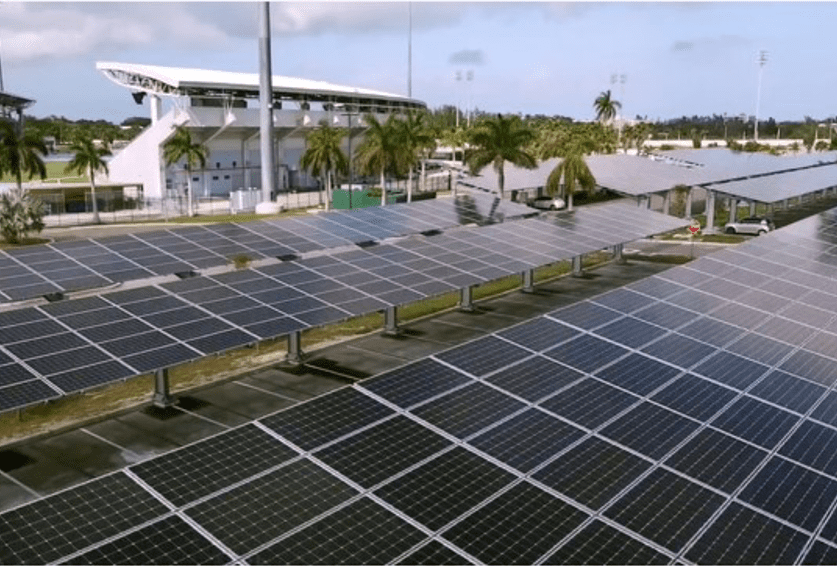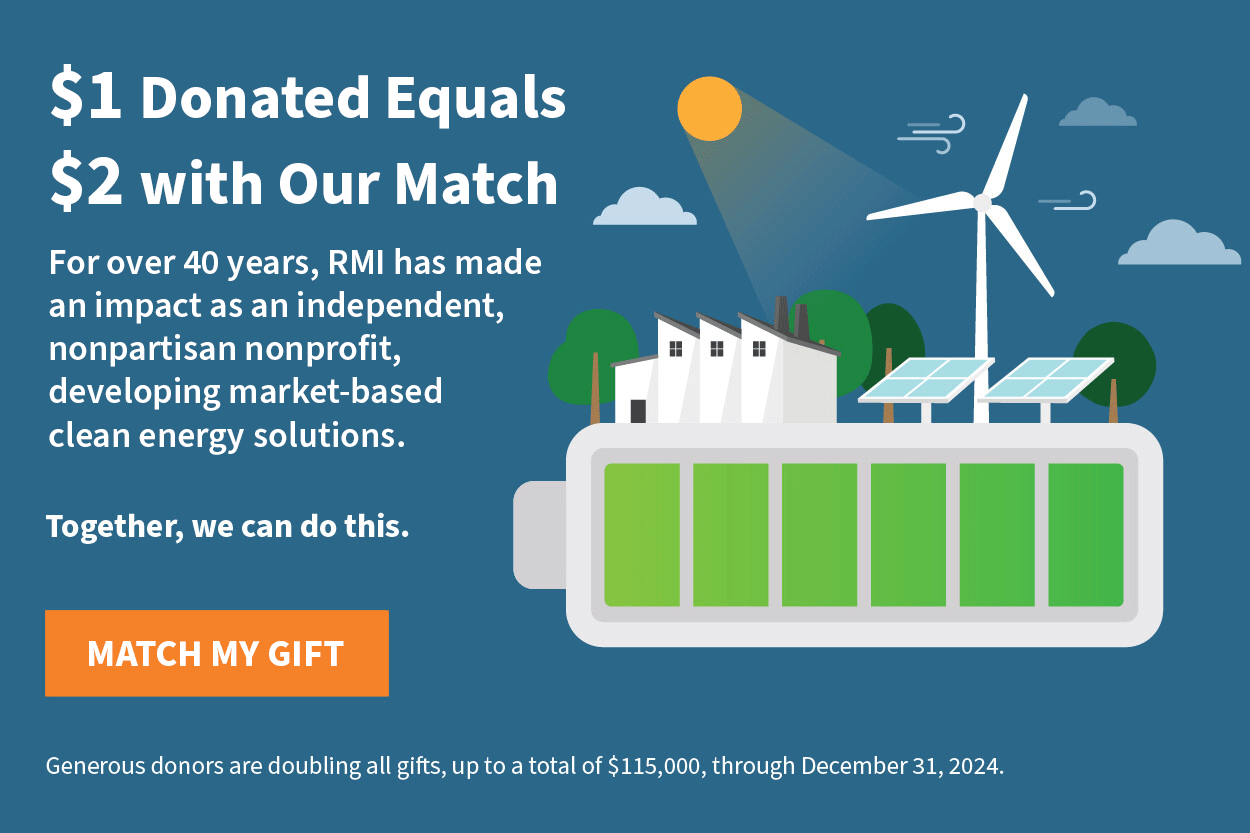
Beyond 60 Minutes: The Caribbean, Center Stage for the Soft Energy Pathway
In 1976, RMI co-founder Amory Lovins wrote “Energy Strategy: The Road Not Taken?”, which outlined his proposal for a “soft energy pathway” for global security. In an era defined by large centralized electricity generation—primarily powered by coal and nuclear energy in the United States—where power was transmitted hundreds of miles from where it was generated to the businesses and people that consume it, Lovins’ soft pathway doctrine was based on decentralization. In this pathway, the generation of indigenous, renewable-powered electricity derived at or near the site where the energy was actually used would be lower-cost and more secure.
Over forty years later, this original hypothesis is finally being proven at scale. Geopolitical divisions are hardening in the global oil economy. Coupled with the impacts of intensifying climate change, countries, states, cities, and communities are acknowledging that a more decentralized energy system architecture comprised of distributed energy resources (DERs)—such as such as on-site solar, battery energy storage, and microgrids—is safer and more resilient in a rapidly changing political and environmental context.
Nowhere is the business case clearer or the need to transition to a soft pathway more urgent than the Caribbean. The nations in this region not only have some of the highest electricity costs in the world, but also excellent renewable energy resources. In addition, Caribbean islands are highly exposed to disruption from natural hazards. Both this vulnerability and cost are inherently linked to a centralized electricity system running on fossil fuels. As a result of this unique set of ingredients, the region now finds itself center stage for the soft energy pathway…whether it wanted it or not.
Surviving disasters
As the planet continues to warm, increased moisture in the air will translate into even more severe and frequent tropical storms and hurricanes. The trend is alarming. There have been 34 Category 5 (CAT 5) hurricanes recorded in the Atlantic over the last 150 years. Ten of those CAT 5 hurricanes have come in the last 15 years—with five of those occurring in the last three years. The devastation seen with Hurricane Dorian (CAT 5+) in The Bahamas in 2019, Hurricane Maria in Puerto Rico in 2017, and Hurricane Irma affecting Barbuda and The British Virgin Islands in 2017 is likely to become commonplace.
These conditions are not limited to the Caribbean. While California represents a different geographical context, it shares the same electricity system architecture of centralized power generation with transmission networks spreading hundreds of miles. Due in part to windy, dry weather that has increased the risk of fire, California utilities have repeatedly shut down the grid to avoid any chance of the type of power line accident that sparked the deadly wildfire in the small town of Paradise in 2018. The result of such forced outages has been millions of homes and businesses losing power for long periods of time. Regardless, those efforts did not prevent the Kincade Fire in 2019 from spreading throughout Northern California.
The economic impacts of the 2018 fires alone have been estimated at $400 billion—nearly double the annual budget for the entire state. The costs of the mandatory blackouts that California utilities have been implementing to try to avoid additional wildfire damage are exorbitant as well. Consider, for example, the cost of outages on schools: The proactive power shut-off implemented in 2019 during the Kincade Fire caused approximately 500,000 students to miss school, at an estimated societal cost of $14 million dollars per day.
Whether it is high wind events in the Caribbean, Gulf Coast, or the US Southeast; floods in the Midwest; or fires in the West, these catastrophic events highlight how vulnerable our fragile world is even in usual years, when the world is not facing a global pandemic. Nowhere is this more evident than in our electricity grids, as electricity is the lifeblood of an economy. If a storm shuts down a central power plant or knocks down a transmission line, then populations, services, and businesses go dark. The many miles of power lines that deliver power to customers are both highly vulnerable and expensive to rebuild. As the world saw in both New York after Super Storm Sandy and Puerto Rico after Hurricane Maria, diesel fuel shipments for backup generation can be limited and unreliable, particularly if both ports and roads are compromised. More importantly, disruptions to power supply lead to follow-on disruptions to hospitals and other health facilities, water infrastructure, telecommunications, community service organizations, shelters, businesses, first responders, schools, and other critical facilities.
Cost declines for solar photovoltaics (PV) over the last few decades and more recently for battery storage have allowed DERs such as renewable energy-based microgrids to be cost-competitive with the electricity grid. Recent RMI research summarized in the two Solar Under Storm reports from 2018 and 2020 shows that minor and cost-effective steps can be taken to ensure that solar PV systems can survive in the face of hurricane-force winds—keeping the lights on during and immediately after the storm. DERs and grid segmentation are critical to creating more resilient power systems at a time when climate change is putting more stress on grids. Whether islanded or connected to the grid, microgrids are becoming an important and increasingly favored option over large-scale, centralized electricity generation.
Leadership in The Bahamas
Through RMI’s work in The Bahamas and across the broader Caribbean region, we are helping to ensure that investors pursue the optimal economic solution for investing in the region today. This involves a combination of proper planning and sound project preparation, as well as de-risking and aggregating projects through competitive procurement. Furthermore, we have proven that solar systems are capable of surviving even the most severe category of hurricane.
In The Bahamas, RMI worked with Bahamas Power and Light Company (BPL) to develop and install a solar car park canopy at the National Stadium in Nassau that can withstand the winds of a category five hurricane, as part of a resilient microgrid. When Nassau was hit in the outer bands of Hurricane Dorian in 2019, the island lost power while this array continued producing electricity during and immediately after the storm.

RMI also worked with BPL to build the country’s first category five resilient solar and battery storage microgrid on Ragged Island, which was featured in a recent 60 Minutes segment.
We are now focusing on designing and delivering sustainable and resilient microgrids for critical facilities in The Abacos Islands, a chain in The Bahamas, following the destruction wrought by Hurricane Dorian last year. Lessons learned from The Bahamas will help in our ongoing work to scale and proliferate the number of distributed solar-plus-storage microgrids at critical facilities across the Caribbean and globally. These microgrids power critical infrastructure and will improve the overall operations of the larger grid to which they are connected, as well as reducing economic losses and saving lives during and after major storms.
From a broader perspective, RMI is strategically encouraging the practice of leveraging microgrids at critical facilities as a mechanism to help open the distributed energy market further. This work forces regulators to think through a new framework that enables distributed generation at scale, and it encourages the utility and private sector to innovate around business models that replace the status quo and thrive. Wood Mackenzie recently reported that the Caribbean is one of the most active customer-sited microgrid markets in the world, and the market is expected to more than double in size by late 2024.
The time has come to transition to a twenty-first century, decentralized grid
Whether these microgrids are connected to a larger transmission and distribution grid or islanded will be determined locally, taking into consideration factors such as the quality and stability of already-existing grid infrastructure, the needs of the community, the geography of the site, and other factors unique to each situation.
At RMI, we have a front row seat to the Caribbean energy transition, working with more than 15 countries in the region to accelerate and guide their energy transitions. As featured in the 60 Minutes segment, we are working on a cutting-edge energy rebuild in The Abacos. In the process, we can move ahead with twenty-first century energy systems that will make The Bahamas and the entire Caribbean region more cost-efficient and more resilient to future storms. We have learned through addressing these challenges that there are key ingredients required to accelerate the decentralization of the grid, regardless of its size. These may seem intuitive yet are rarely implemented in practice. At RMI, we believe there are three key lessons that can be extrapolated from the Caribbean experience:
First, you need a plan that enables you to get from where you are today to where you want to go. It is critical that stakeholders (government, utility, regulator, and the public) align around a core vision and jointly develop a plan to achieve this vision in an inclusive manner. In a centralized energy system electricity production is hidden away, whereas in a decentralized energy system these new assets become part of the common landscape. This is a very personal thing in a small community, and everyone wants to and should have a say in what their world looks like.
This plan should also be based on a strong understanding of the technical parameters of the grid as well as the underlying economics of the electricity sector. If the plan is too aspirational or high level, it can often restrict progress as opposed to accelerate it. It should chart the least cost and most resilient pathway that leads to a transition, and it must have buy-in from all stakeholders, otherwise you will run into pitfalls later in the journey.
Next, stakeholders need to act because there are societal and economic costs to waiting. Whether a big step or a baby step is taken, it is critical to take action to overcome inertia and move the transition process forward—thereby proving that the vision and the plan can be actualized. Of course, this takes leadership at multiple levels. Without it, projects will inevitably stall. Most importantly, the utility must demonstrate leadership in the process. The harder the utility fights against change, the more difficult the inevitable transition will be for it and the sector as a whole.
Last, and most importantly, collaboration is critical for a decentralized energy sector to be realized. No single utility, government, or country can facilitate this transition alone, and most communities do not have the capital to make a mistake. You may only get one chance at this so you must learn from others. This means collaboration between and among stakeholders and with outside knowledge providers, and most importantly, with other communities going through the same journey. Most of all, it requires human energy, which flourishes when given a collaborative learning environment.
At RMI, we’ve helped nourish the energy transition through the community of Caribbean renewable energy practitioners, and we are now seeing utility engineers, government policymakers, and regulatory staff learn from one another and tackle enormous challenges together.
The era of the centralized grid will soon come to an end
In line with Lovins’ original thesis of the soft energy path, the Caribbean is close to capturing the benefits of a decentralized energy architecture. This is in part due to proactive planning, but primarily because the region is on the front lines of climate change and must take action. In the process, the Caribbean is developing a scalable blueprint for what an equitable energy transition looks like from a technical, economic, financial, and regulatory perspective, while demonstrating the enabling business models and regulatory frameworks required to scale DERs as part of a decentralized pathway. The world is now watching the Caribbean, as the insights gleaned from the islands today will ultimately shape how to globally scale the soft pathway across the world tomorrow.
